Cannabidiol: Difference between revisions
add under USA |
→Legal status: FDA approval of first drug for Dravet Syndrome |
||
| Line 134: | Line 134: | ||
===Legal status=== |
===Legal status=== |
||
====U.S. Food and Drug Administration==== |
|||
The FDA has approved the first drug that contains purified cannabidiol derived from cannabis/hemp. It is the first drug approved for the treatment of patients with Dravet syndrome. The FDA granted Priority Review<ref>https://www.fda.gov/ForPatients/Approvals/Fast/ucm405405.htm</ref> designation for this application. Fast-Track<ref>https://www.fda.gov/ForPatients/Approvals/Fast/ucm405399.htm</ref> designation was granted for Dravet syndrome. A designation of Orphan Drug<ref>https://www.fda.gov/ForIndustry/DevelopingProductsforRareDiseasesConditions/HowtoapplyforOrphanProductDesignation/default.htm</ref> was granted for both the Dravet syndrome and Lennox-Gastaut syndrome indications. GW Research Ltd.<ref>https://www.gwpharm.com/epilepsy-patients-caregivers/clinicians-researchers/research</ref> was given the FDA approval of Epidiolex. |
|||
====Non-psychoactivity==== |
|||
CBD does not appear to have any psychoactive ("high") effects such as those caused by ∆9-THC in marijuana, but may have anti-anxiety and anti-psychotic effects.<ref name=Iseger2015/> As the legal landscape and understanding about the differences in medical cannabinoids unfolds, it will be increasingly important to distinguish "medical marijuana" (with noted varying degrees of psychotropic effects and deficits in executive function) – from "medical CBD".<ref name=Iseger2015>{{cite journal | vauthors = Iseger TA, Bossong MG | title = A systematic review of the antipsychotic properties of cannabidiol in humans | journal = Schizophrenia Research | volume = 162 | issue = 1–3 | pages = 153–61 | date = March 2015 | pmid = 25667194 | doi = 10.1016/j.schres.2015.01.033 }}</ref><ref>{{cite journal | vauthors = Sachs J, McGlade E, Yurgelun-Todd D | title = Safety and Toxicology of Cannabinoids | journal = Neurotherapeutics | volume = 12 | issue = 4 | pages = 735–46 | date = October 2015 | pmid = 26269228 | pmc = 4604177 | doi = 10.1007/s13311-015-0380-8 }}</ref> |
CBD does not appear to have any psychoactive ("high") effects such as those caused by ∆9-THC in marijuana, but may have anti-anxiety and anti-psychotic effects.<ref name=Iseger2015/> As the legal landscape and understanding about the differences in medical cannabinoids unfolds, it will be increasingly important to distinguish "medical marijuana" (with noted varying degrees of psychotropic effects and deficits in executive function) – from "medical CBD".<ref name=Iseger2015>{{cite journal | vauthors = Iseger TA, Bossong MG | title = A systematic review of the antipsychotic properties of cannabidiol in humans | journal = Schizophrenia Research | volume = 162 | issue = 1–3 | pages = 153–61 | date = March 2015 | pmid = 25667194 | doi = 10.1016/j.schres.2015.01.033 }}</ref><ref>{{cite journal | vauthors = Sachs J, McGlade E, Yurgelun-Todd D | title = Safety and Toxicology of Cannabinoids | journal = Neurotherapeutics | volume = 12 | issue = 4 | pages = 735–46 | date = October 2015 | pmid = 26269228 | pmc = 4604177 | doi = 10.1007/s13311-015-0380-8 }}</ref> |
||
Revision as of 00:29, 26 June 2018
 | |
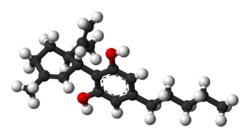 | |
| Clinical data | |
|---|---|
| AHFS/Drugs.com | International Drug Names |
| ATC code |
|
| Legal status | |
| Legal status |
|
| Pharmacokinetic data | |
| Bioavailability | Oral: 13–19%[1] Inhaled: 11–45% (mean 31%)[2] |
| Elimination half-life | 9 hours[1] |
| Identifiers | |
| |
| CAS Number | |
| PubChem CID | |
| IUPHAR/BPS | |
| DrugBank | |
| ChemSpider | |
| UNII | |
| ChEBI | |
| CompTox Dashboard (EPA) | |
| ECHA InfoCard | 100.215.986 |
| Chemical and physical data | |
| Formula | C21H30O2 |
| Molar mass | 314.464 g/mol g·mol−1 |
| 3D model (JSmol) | |
| Melting point | 66 °C (151 °F) |
| |
| |
| | |
| Part of a series on |
| Cannabis |
|---|
 |
Cannabidiol (INN;[3] abbreviated as: CBD) is one of at least 113 cannabinoids identified in cannabis.[4][5] It is a major phytocannabinoid, accounting for up to 40% of the plant's extract.[6] CBD does not have intoxicating effects like those caused by tetrahydrocannabinol (THC) and may have a downregulating effect on disordered thinking and anxiety.[7][8]
Uses
Pain associated with multiple sclerosis
Nabiximols (USAN, trade name Sativex) is an aerosolized mist for oral administration containing a near 1:1 ratio of CBD and THC. The drug was approved by Canadian authorities in 2005 to alleviate pain associated with multiple sclerosis.[9]
Research
Addiction treatment
Systematic reviews of preliminary research showed cannabidiol had potential for improving tobacco and cannabis dependence, although as of 2016, they indicate limited high-quality evidence for anti-addictive effects in people.[10][11][12]
Epilepsy
A 2014 Cochrane review included four randomized controlled trials, but all were of poor quality, and no reliable conclusions could be made about the effect of cannabidiol on epilepsy from the review or from similar reports.[13][14][15] Cannabidiol is the active ingredient in Epidiolex, which was approved by the US Food and Drug Administration in June 2018 as a treatment for the rare forms of childhood epilepsy, Lennox-Gastaut syndrome and Dravet syndrome.[16]
Anxiolytic
A 2016 review indicated that cannabidiol has potential as an anxiolytic for relief of anxiety-related disorders, such as PTSD, phobias, and fear.[8]
Adverse effects
Cannabidiol safety in humans has been studied in several small studies, suggesting that it is well-tolerated, but with tiredness, diarrhea and decreased appetite as common adverse effects.[17]
Interactions
There is preclinical evidence to suggest that cannabidiol may reduce THC clearance, modestly increasing THC's plasma concentrations resulting in a greater amount of THC available to receptors, increasing the effect of THC in a dose-dependent manner.[18][19] Despite this, the available evidence in humans suggests no significant effect of CBD on THC plasma levels.[20]
Pharmacology
Pharmacodynamics
Cannabidiol has very low affinity for the cannabinoid CB1 and CB2 receptors but acts as an indirect antagonist of these receptors.[21][22] It may potentiate THC's effects by increasing CB1 receptor density or through another CB1 receptor-related mechanism.[23] Cannabidiol may also extend the duration of the effects of THC via inhibition of the cytochrome P450, CYP3A and CYP2C enzymes.[24][unreliable source?]
Cannabidiol has been found to act as an antagonist of GPR55, a G protein-coupled receptor and putative cannabinoid receptor that is expressed in the caudate nucleus and putamen in the brain.[25] It has also been shown to act as a 5-HT1A receptor partial agonist,[26] and this action may be involved in the antidepressant,[27][28] anxiolytic,[28][29] and neuroprotective[30][31] effects of cannabidiol. It is an allosteric modulator of the μ- and δ-opioid receptors as well.[32] Cannabidiol's pharmacological effects have additionally been attributed to PPARγ agonism and intracellular calcium release.[6]
Research suggests that CBD may exert some of its pharmacological action through its inhibition of fatty acid amide hydrolase (FAAH), which may in turn increase the levels of endocannabinoids, such as anandamide, produced by the body.[6] It has also been speculated that some of the metabolites of CBD have pharmacological effects that contribute to the biological activity of CBD.[33]
Chemistry
Cannabidiol is insoluble in water but soluble in organic solvents such as pentane. At room temperature, it is a colorless crystalline solid.[34] In strongly basic media and the presence of air, it is oxidized to a quinone.[35] Under acidic conditions it cyclizes to THC.[36] The synthesis of cannabidiol has been accomplished by several research groups.[37][38][39]
Biosynthesis
Cannabis produces CBD-carboxylic acid through the same metabolic pathway as THC, until the next to last step, where CBDA synthase performs catalysis instead of THCA synthase.[40]

Isomerism
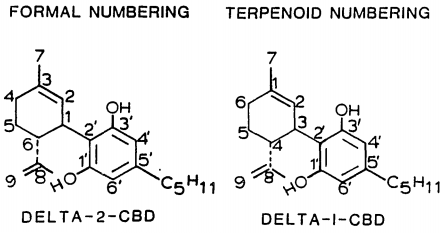
| 7 double bond isomers and their 30 stereoisomers | ||||||||
|---|---|---|---|---|---|---|---|---|
| Formal numbering | Terpenoid numbering | Number of stereoisomers | Natural occurrence | Convention on Psychotropic Substances Schedule | Structure | |||
| Short name | Chiral centers | Full name | Short name | Chiral centers | ||||
| Δ5-cannabidiol | 1 and 3 | 2-(6-isopropenyl-3-methyl-5-cyclohexen-1-yl)-5-pentyl-1,3-benzenediol | Δ4-cannabidiol | 1 and 3 | 4 | No | unscheduled | 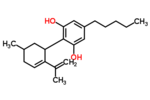
|
| Δ4-cannabidiol | 1, 3 and 6 | 2-(6-isopropenyl-3-methyl-4-cyclohexen-1-yl)-5-pentyl-1,3-benzenediol | Δ5-cannabidiol | 1, 3 and 4 | 8 | No | unscheduled | 
|
| Δ3-cannabidiol | 1 and 6 | 2-(6-isopropenyl-3-methyl-3-cyclohexen-1-yl)-5-pentyl-1,3-benzenediol | Δ6-cannabidiol | 3 and 4 | 4 | ? | unscheduled | 
|
| Δ3,7-cannabidiol | 1 and 6 | 2-(6-isopropenyl-3-methylenecyclohex-1-yl)-5-pentyl-1,3-benzenediol | Δ1,7-cannabidiol | 3 and 4 | 4 | No | unscheduled | 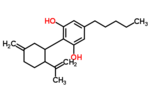
|
| Δ2-cannabidiol | 1 and 6 | 2-(6-isopropenyl-3-methyl-2-cyclohexen-1-yl)-5-pentyl-1,3-benzenediol | Δ1-cannabidiol | 3 and 4 | 4 | Yes | unscheduled | 
|
| Δ1-cannabidiol | 3 and 6 | 2-(6-isopropenyl-3-methyl-1-cyclohexen-1-yl)-5-pentyl-1,3-benzenediol | Δ2-cannabidiol | 1 and 4 | 4 | No | unscheduled | 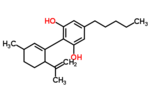
|
| Δ6-cannabidiol | 3 | 2-(6-isopropenyl-3-methyl-6-cyclohexen-1-yl)-5-pentyl-1,3-benzenediol | Δ3-cannabidiol | 1 | 2 | No | unscheduled | 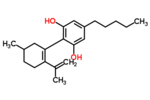
|
See also: Tetrahydrocannabinol#Isomerism, Abnormal cannabidiol.
Society and culture
Food and beverage
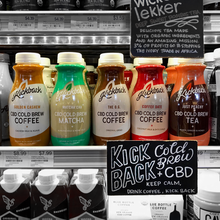
Similar to recreational marijuana, food and beverage items can be infused with CBD as an alternative means of ingesting the substance.[42] In the United States, a number of products are marketed as containing CBD, but in reality contain little or none.[43]
CBD-infused food is increasingly becoming commonplace in the United States, as natural grocers are now picking up food and beverage products with CBD in them.[44] However, some companies marketing CBD-infused food products with claims that are similar to the effects of prescription drugs have received warning letters from the Food and Drug Administration for making unsubstantiated claims.[45]
Natural sources
Selective breeding by growers in the USA dramatically lowered the CBD content of cannabis; their customers preferred varietals that were more mind-altering due to a higher THC and lower CBD content.[46] To meet the demands of medical cannabis patients, growers are currently developing more CBD-dominant strains.[47] The growth in popularity of CBD has resulted in further selective breeding by growers intended to increase the CBD levels and lower the THC levels. Today, most CBD products on the market are sourced from industrial hemp which is classified as cannabis containing no more than 0.3% THC by dry weight.[48]
Legal status
U.S. Food and Drug Administration
The FDA has approved the first drug that contains purified cannabidiol derived from cannabis/hemp. It is the first drug approved for the treatment of patients with Dravet syndrome. The FDA granted Priority Review[49] designation for this application. Fast-Track[50] designation was granted for Dravet syndrome. A designation of Orphan Drug[51] was granted for both the Dravet syndrome and Lennox-Gastaut syndrome indications. GW Research Ltd.[52] was given the FDA approval of Epidiolex.
Non-psychoactivity
CBD does not appear to have any psychoactive ("high") effects such as those caused by ∆9-THC in marijuana, but may have anti-anxiety and anti-psychotic effects.[7] As the legal landscape and understanding about the differences in medical cannabinoids unfolds, it will be increasingly important to distinguish "medical marijuana" (with noted varying degrees of psychotropic effects and deficits in executive function) – from "medical CBD".[7][53]
Various breeds/strains of "medical marijuana" are found to have a significant variation in the ratios of CBD-to-THC and are known to contain other non-psychotropic cannabinoids.[54] However it is only the amount of ∆9-THC that chemically gives a legal determination as to whether the plant material(s) used for the purposes of extracting CBD are considered hemp, or considered marijuana.[citation needed]
Any psychoactive marijuana, regardless of its CBD content, is derived from the flower (or bud) of the genus Cannabis. Non-psychoactive hemp (also commonly-termed industrial hemp), regardless of its CBD content, is any part of the cannabis plant, whether growing or not, containing a ∆-9 tetrahydrocannabinol concentration of no more than three-tenths of one percent (0.3%) on a dry weight basis. Certain standards are required for legal growing, cultivating and producing the hemp plant. The Colorado Industrial Hemp Program registers growers of industrial hemp and samples crops to verify that the THC concentration does not exceed 0.3% on dry weight basis.[55]
United Nations
Cannabidiol is not scheduled by the Convention on Psychotropic Substances.
United States
In the United States, cannabidiol is a Schedule I drug under the Controlled Substances Act.[56] This means that production, distribution and possession of CBD is illegal under federal law. In 2016, the Drug Enforcement Administration added "marijuana extracts" to the list of Schedule I drugs, which it defined as "an extract containing one or more cannabinoids that has been derived from any plant of the genus Cannabis, other than the separated resin (whether crude or purified) obtained from the plant."[57] Previously, CBD had simply been considered "marijuana", which is also a Schedule I drug.[56][58] In June 2018, the FDA approved oral use of CBD as an anti-seizure drug in treating rare types of childhood epilepsy.[16]
A CNN program that featured Charlotte's Web cannabis in 2013 brought increased attention to the use of CBD in the treatment of seizure disorders.[59][60] Since then, 16 states have passed laws to allow for the use of CBD products (not exceeding a specified concentration of THC) for the treatment of certain medical conditions.[61] This is in addition to the 30 states that have passed comprehensive medical cannabis laws, which allow for the use of cannabis products with no restrictions on THC content.[61] Of these 30 states, eight have legalized the use and sale of cannabis products without requirement for a doctor's recommendation.[61]
Although most states restrict the use of CBD products to certain medical conditions, manufacturers of CBD claim their products are derived from industrial hemp, and therefore legal for anyone to use.[62] A number of these manufacturers ship CBD products to all 50 states, which the federal government has so far not intervened in.[63][64] CBD is also openly sold in head shops and health food stores in some states where such sales have not been explicitly legalized.[62][65]
Australia
Prescription medicine (Schedule 4) for therapeutic use containing 2 per cent (2.0%) or less of other cannabinoids commonly found in cannabis (such as ∆9-THC). A schedule 4 drug under the SUSMP is Prescription Only Medicine, or Prescription Animal Remedy – Substances, the use or supply of which should be by or on the order of persons permitted by State or Territory legislation to prescribe and should be available from a pharmacist on prescription.[66]
New Zealand
Cannabidiol is currently a class B1 controlled drug in New Zealand under the Misuse of Drugs Act. It is also a prescription medicine under the Medicines Act. In 2017 the rules were changed so that anyone wanting to use it could go to the Health Ministry for approval. Prior to this, the only way to obtain a prescription was to seek the personal approval of the Minister of Health.
Associate Health Minister Peter Dunne said restrictions would be removed, which means a doctor will now be able to prescribe cannabidiol to patients.[67]
Canada
Cannabidiol is a Schedule II drug in Canada. As such, it is only available with a prescription.[68] It is available as a spray, called Sativex produced by GW Pharmaceuticals in the UK, for use in multiple sclerosis. The Canadian Government announced that October 17, 2018 is the date when marijuana can be consumed recreationally without criminal penalties,[69] indicating that various cannabidiol products will be freely available to adult consumers.
Europe
Cannabidiol is listed in the EU Cosmetics Ingredient Database (CosIng).[70] However, the listing of an ingredient, assigned with an INCI name, in CosIng does not mean it is to be used in cosmetic products nor approved for such use.[71]
Cannabidiol is listed in the EU Novel Food Catalogue.[72] This listing only applies to isolated or synthetic CBD, not to crude hemp extracts or tinctures naturally containing CBD.
The European Industrial Hemp Association has issued a position paper suggesting regulatory framework in EU.[73]
Several industrial hemp varieties can be legally cultivated in western Europe. A variety such as "Fedora 17" has a cannabinoid profile consistently around 1% cannabidiol (CBD) with THC less than 0.1%.[74]
Although the World Health Organization listed Cannabidiolum in a list of International Nonproprietary Names for Pharmaceutical Substances (INN) on 30 June 2016. French and Spanish versions wrongly mention agonist action of CBD on cannabinoid receptors while the English version says CBD is a cannabinoid receptor antagonist.[citation needed]
Sweden
CBD is not classified in Sweden.
Sativex (CBD and THC) is a prescription product available for relief of severe spasticity due to multiple sclerosis.[75][76]
United Kingdom
Cannabidiol, in an oral-mucosal spray formulation combined with delta-9-tetrahydrocannabinol, is a prescription product available for relief of severe spasticity due to multiple sclerosis (where other anti-spasmodics have not been effective).[77]
As of 31 December 2016, products containing cannabidiol that are marketed for medical purposes are classed as medicines by the UK regulatory body, the Medicines and Healthcare products Regulatory Agency (MHRA) and cannot be marketed without regulatory approval for the medical claims.[78]
Switzerland
While THC remains illegal, CBD is not subject to the Swiss Narcotic Acts because this substance does not produce a comparable psychoactive effect.[79] Cannabis products containing less than 1% THC can be sold and purchased legally.[80]
See also
References
- ^ a b Mechoulam R, Parker LA, Gallily R (November 2002). "Cannabidiol: an overview of some pharmacological aspects". Journal of Clinical Pharmacology. 42 (11 Suppl): 11S–19S. doi:10.1002/j.1552-4604.2002.tb05998.x. PMID 12412831.
- ^ Scuderi C, Filippis DD, Iuvone T, Blasio A, Steardo A, Esposito G (May 2009). "Cannabidiol in medicine: a review of its therapeutic potential in CNS disorders". Phytotherapy Research (Review). 23 (5): 597–602. doi:10.1002/ptr.2625. PMID 18844286.
- ^ "International Nonproprietary Names for Pharmaceutical Substances (INN)" (PDF). WHO Drug Information. 30 (2): 241. 2016.
- ^ Borgelt LM, Franson KL, Nussbaum AM, Wang GS (February 2013). "The pharmacologic and clinical effects of medical cannabis". Pharmacotherapy (Review). 33 (2): 195–209. doi:10.1002/phar.1187. PMID 23386598.
- ^ Aizpurua-Olaizola O, Soydaner U, Öztürk E, Schibano D, Simsir Y, Navarro P, Etxebarria N, Usobiaga A (February 2016). "Evolution of the Cannabinoid and Terpene Content during the Growth of Cannabis sativa Plants from Different Chemotypes". Journal of Natural Products. 79 (2): 324–31. doi:10.1021/acs.jnatprod.5b00949. PMID 26836472.
- ^ a b c Campos AC, Moreira FA, Gomes FV, Del Bel EA, Guimarães FS (December 2012). "Multiple mechanisms involved in the large-spectrum therapeutic potential of cannabidiol in psychiatric disorders". Philosophical Transactions of the Royal Society of London. Series B, Biological Sciences (Review). 367 (1607): 3364–78. doi:10.1098/rstb.2011.0389. PMC 3481531. PMID 23108553.
- ^ a b c Iseger TA, Bossong MG (March 2015). "A systematic review of the antipsychotic properties of cannabidiol in humans". Schizophrenia Research. 162 (1–3): 153–61. doi:10.1016/j.schres.2015.01.033. PMID 25667194.
- ^ a b Jurkus, R; Day, H. L; Guimarães, F. S; Lee, J. L; Bertoglio, L. J; Stevenson, C. W (2016). "Cannabidiol Regulation of Learned Fear: Implications for Treating Anxiety-Related Disorders". Frontiers in Pharmacology. 7: 454. doi:10.3389/fphar.2016.00454. PMC 5121237. PMID 27932983.
{{cite journal}}: CS1 maint: unflagged free DOI (link) - ^ "Fact Sheet — Sativex". Health Canada. Retrieved May 16, 2013.
- ^ Zlebnik, N. E; Cheer, J. F (2016). "Beyond the CB1 Receptor: Is Cannabidiol the Answer for Disorders of Motivation?". Annual Review of Neuroscience. 39: 1–17. doi:10.1146/annurev-neuro-070815-014038. PMC 5818147. PMID 27023732.
- ^ Prud'homme M, Cata R, Jutras-Aswad D (2015). "Cannabidiol as an Intervention for Addictive Behaviors: A Systematic Review of the Evidence". Substance Abuse. 9: 33–8. doi:10.4137/SART.S25081. PMC 4444130. PMID 26056464.
- ^ Hurd YL, Yoon M, Manini AF, Hernandez S, Olmedo R, Ostman M, Jutras-Aswad D (October 2015). "Early Phase in the Development of Cannabidiol as a Treatment for Addiction: Opioid Relapse Takes Initial Center Stage". Neurotherapeutics. 12 (4): 807–15. doi:10.1007/s13311-015-0373-7. PMC 4604178. PMID 26269227.
- ^ Gloss D, Vickrey B (March 2014). "Cannabinoids for epilepsy". The Cochrane Database of Systematic Reviews (3): CD009270. doi:10.1002/14651858.CD009270.pub3. PMID 24595491.
- ^ Friedman D, Devinsky O (September 2015). "Cannabinoids in the Treatment of Epilepsy". The New England Journal of Medicine. 373 (11): 1048–58. doi:10.1056/NEJMra1407304. PMID 26352816.
- ^ Welty TE, Luebke A, Gidal BE (September 2014). "Cannabidiol: promise and pitfalls". Epilepsy Currents. 14 (5): 250–2. doi:10.5698/1535-7597-14.5.250. PMC 4189631. PMID 25346628.
- ^ a b "FDA approves first drug comprised of an active ingredient derived from marijuana to treat rare, severe forms of epilepsy". US Food and Drug Administration. June 25, 2018. Retrieved June 25, 2018.
- ^ Iffland K, Grotenhermen F (2017). "An Update on Safety and Side Effects of Cannabidiol: A Review of Clinical Data and Relevant Animal Studies". Cannabis Cannabinoid Res. 2 (1): 139–154. doi:10.1089/can.2016.0034. PMC 5569602. PMID 28861514.
- ^ Bornheim LM, Kim KY, Li J, Perotti BY, Benet LZ (August 1995). "Effect of cannabidiol pretreatment on the kinetics of tetrahydrocannabinol metabolites in mouse brain". Drug Metabolism and Disposition. 23 (8): 825–831. PMID 7493549.
- ^ Klein C, Karanges E, Spiro A, Wong A, Spencer J, Huynh T, Gunasekaran N, Karl T, Long LE, Huang XF, Liu K, Arnold JC, McGregor IS (November 2011). "Cannabidiol potentiates Δ⁹-tetrahydrocannabinol (THC) behavioural effects and alters THC pharmacokinetics during acute and chronic treatment in adolescent rats". Psychopharmacology. 218 (2): 443–457. doi:10.1007/s00213-011-2342-0. PMID 21667074.
- ^ Hunt CA, Jones RT, Herning RI, Bachman J (June 1981). "Evidence that cannabidiol does not significantly alter the pharmacokinetics of tetrahydrocannabinol in man". Journal of Pharmacokinetics and Biopharmaceutics. 9 (3): 245–260. doi:10.1007/BF01059266. PMID 6270295.
- ^ Mechoulam R, Peters M, Murillo-Rodriguez E, Hanus LO (August 2007). "Cannabidiol--recent advances". Chemistry & Biodiversity (Review). 4 (8): 1678–92. doi:10.1002/cbdv.200790147. PMID 17712814.
- ^ Pertwee RG (January 2008). "The diverse CB1 and CB2 receptor pharmacology of three plant cannabinoids: delta9-tetrahydrocannabinol, cannabidiol and delta9-tetrahydrocannabivarin". British Journal of Pharmacology. 153 (2): 199–215. doi:10.1038/sj.bjp.0707442. PMC 2219532. PMID 17828291.
- ^ Hayakawa K, Mishima K, Hazekawa M, Sano K, Irie K, Orito K, Egawa T, Kitamura Y, Uchida N, Nishimura R, Egashira N, Iwasaki K, Fujiwara M (January 2008). "Cannabidiol potentiates pharmacological effects of Delta(9)-tetrahydrocannabinol via CB(1) receptor-dependent mechanism". Brain Research. 1188: 157–64. doi:10.1016/j.brainres.2007.09.090. PMID 18021759.
- ^ Alchimia Blog, Cannabinoids and their medicinal properties
- ^ Ryberg E, Larsson N, Sjögren S, Hjorth S, Hermansson NO, Leonova J, Elebring T, Nilsson K, Drmota T, Greasley PJ (December 2007). "The orphan receptor GPR55 is a novel cannabinoid receptor". British Journal of Pharmacology. 152 (7): 1092–101. doi:10.1038/sj.bjp.0707460. PMC 2095107. PMID 17876302.
- ^ Russo EB, Burnett A, Hall B, Parker KK (August 2005). "Agonistic properties of cannabidiol at 5-HT1a receptors". Neurochemical Research. 30 (8): 1037–43. doi:10.1007/s11064-005-6978-1. PMID 16258853.
- ^ Zanelati TV, Biojone C, Moreira FA, Guimarães FS, Joca SR (January 2010). "Antidepressant-like effects of cannabidiol in mice: possible involvement of 5-HT1A receptors". British Journal of Pharmacology. 159 (1): 122–8. doi:10.1111/j.1476-5381.2009.00521.x. PMC 2823358. PMID 20002102.
- ^ a b Resstel LB, Tavares RF, Lisboa SF, Joca SR, Corrêa FM, Guimarães FS (January 2009). "5-HT1A receptors are involved in the cannabidiol-induced attenuation of behavioural and cardiovascular responses to acute restraint stress in rats". British Journal of Pharmacology. 156 (1): 181–8. doi:10.1111/j.1476-5381.2008.00046.x. PMC 2697769. PMID 19133999.
- ^ Campos AC, Guimarães FS (August 2008). "Involvement of 5HT1A receptors in the anxiolytic-like effects of cannabidiol injected into the dorsolateral periaqueductal gray of rats". Psychopharmacology. 199 (2): 223–30. doi:10.1007/s00213-008-1168-x. PMID 18446323.
- ^ Mishima K, Hayakawa K, Abe K, Ikeda T, Egashira N, Iwasaki K, Fujiwara M (May 2005). "Cannabidiol prevents cerebral infarction via a serotonergic 5-hydroxytryptamine1A receptor-dependent mechanism". Stroke. 36 (5): 1077–82. doi:10.1161/01.STR.0000163083.59201.34. PMID 15845890.
- ^ Hayakawa K, Mishima K, Nozako M, Ogata A, Hazekawa M, Liu AX, Fujioka M, Abe K, Hasebe N, Egashira N, Iwasaki K, Fujiwara M (March 2007). "Repeated treatment with cannabidiol but not Delta9-tetrahydrocannabinol has a neuroprotective effect without the development of tolerance". Neuropharmacology. 52 (4): 1079–87. doi:10.1016/j.neuropharm.2006.11.005. PMID 17320118.
- ^ Kathmann M, Flau K, Redmer A, Tränkle C, Schlicker E (February 2006). "Cannabidiol is an allosteric modulator at mu- and delta-opioid receptors". Naunyn-Schmiedeberg's Archives of Pharmacology. 372 (5): 354–61. doi:10.1007/s00210-006-0033-x. PMID 16489449.
- ^ Ujváry I, Hanuš L (2014). "Human Metabolites of Cannabidiol: A Review on Their Formation, Biological Activity, and Relevance in Therapy". Cannabis and Cannabinoid Research. 1 (1): 90–101. doi:10.1089/can.2015.0012. PMC 5576600. PMID 28861484.
- ^ Jones PG, Falvello L, Kennard O, Sheldrick GM, Mechoulam R (1977). "Cannabidiol". Acta Crystallogr. B. 33 (10): 3211–3214. doi:10.1107/S0567740877010577.
- ^ Mechoulam R, Ben-Zvi Z, Gaoni Y (August 1968). "Hashish--13. On the nature of the Beam test". Tetrahedron. 24 (16): 5615–24. doi:10.1016/0040-4020(68)88159-1. PMID 5732891.
- ^ Gaoni Y, Mechoulam R (1966). "Hashish—VII The isomerization of cannabidiol to tetrahydrocannabinols". Tetrahedron. 22 (4): 1481–1488. doi:10.1016/S0040-4020(01)99446-3.
- ^ Petrzilka T, Haefliger W, Sikemeier C, Ohloff G, Eschenmoser A (March 1967). "[Synthesis and optical rotation of the (-)-cannabidiols]". Helvetica Chimica Acta. 50 (2): 719–23. doi:10.1002/hlca.19670500235. PMID 5587099.
- ^ Gaoni Y, Mechoulam R (1985). "Boron trifluoride etherate on alumuna — a modified Lewis acid reagent. An improved synthesis of cannabidiol". Tetrahedron Letters. 26 (8): 1083–1086. doi:10.1016/S0040-4039(00)98518-6.
- ^ Kobayashi Y, Takeuchi A, Wang YG (June 2006). "Synthesis of cannabidiols via alkenylation of cyclohexenyl monoacetate". Organic Letters. 8 (13): 2699–702. doi:10.1021/ol060692h. PMID 16774235.
- ^ Marks MD, Tian L, Wenger JP, Omburo SN, Soto-Fuentes W, He J, Gang DR, Weiblen GD, Dixon RA (2009). "Identification of candidate genes affecting Delta9-tetrahydrocannabinol biosynthesis in Cannabis sativa". Journal of Experimental Botany. 60 (13): 3715–26. doi:10.1093/jxb/erp210. PMC 2736886. PMID 19581347.
- ^ Taura F, Sirikantaramas S, Shoyama Y, Yoshikai K, Shoyama Y, Morimoto S (June 2007). "Cannabidiolic-acid synthase, the chemotype-determining enzyme in the fiber-type Cannabis sativa". FEBS Letters. 581 (16): 2929–34. doi:10.1016/j.febslet.2007.05.043. PMID 17544411.
- ^ "CBD-Infused Foods Becoming a New Health Trend and Penetrating the Market". Retrieved December 14, 2017.
- ^ "Warning Letters and Test Results for Cannabidiol-Related Products". Food and Drug Administration. November 2, 2017. Retrieved January 2, 2018.
- ^ "CBD Craze Hits LA's High-End Juice Bars | Leafly". Leafly. April 23, 2018. Retrieved June 7, 2018.
- ^ Ravitz, Arent Fox LLP-James R.; Leongini, Emily M.; Malkin, Brian J. "Companies Marketing CBD Products Be Warned: FDA Is Watching | Lexology". Retrieved December 14, 2017.
{{cite web}}: Unknown parameter|name-list-format=ignored (|name-list-style=suggested) (help) - ^ Romney, Lee (September 13, 2012). "On the frontier of medical pot to treat boy's epilepsy". Los Angeles Times.
{{cite news}}: Unknown parameter|name-list-format=ignored (|name-list-style=suggested) (help) - ^ Good, Alastair (October 26, 2010). "Growing marijuana that won't get you high". The Daily Telegraph. London.
{{cite news}}: Unknown parameter|name-list-format=ignored (|name-list-style=suggested) (help) - ^ "How are CBD Extracts & Isolates Made?". IntelliCBD. June 22, 2018.
- ^ https://www.fda.gov/ForPatients/Approvals/Fast/ucm405405.htm
- ^ https://www.fda.gov/ForPatients/Approvals/Fast/ucm405399.htm
- ^ https://www.fda.gov/ForIndustry/DevelopingProductsforRareDiseasesConditions/HowtoapplyforOrphanProductDesignation/default.htm
- ^ https://www.gwpharm.com/epilepsy-patients-caregivers/clinicians-researchers/research
- ^ Sachs J, McGlade E, Yurgelun-Todd D (October 2015). "Safety and Toxicology of Cannabinoids". Neurotherapeutics. 12 (4): 735–46. doi:10.1007/s13311-015-0380-8. PMC 4604177. PMID 26269228.
- ^ Izzo AA, Borrelli F, Capasso R, Di Marzo V, Mechoulam R (October 2009). "Non-psychotropic plant cannabinoids: new therapeutic opportunities from an ancient herb". Trends in Pharmacological Sciences. 30 (10): 515–27. doi:10.1016/j.tips.2009.07.006. PMID 19729208.
- ^ "Industrial Hemp | Department of Agriculture – Plants". Colorado.gov. Retrieved December 4, 2016.
- ^ a b Hudak, John; Stenglein, Christine (February 6, 2017). "DEA guidance is clear: Cannabidiol is illegal and always has been". FixGov. Brookings Institution. Retrieved December 10, 2017.
{{cite web}}: Unknown parameter|name-list-format=ignored (|name-list-style=suggested) (help) - ^ "Establishment of a New Drug Code for Marijuana Extract". Federal Register. 81 (240): 90194–90196. December 14, 2016. 81 FR 90195
- ^ "Clarification of the New Drug Code (7350) for Marijuana Extract". U.S. Department of Justice. Retrieved December 10, 2017.
- ^ Maa E, Figi P (June 2014). "The case for medical marijuana in epilepsy". Epilepsia. 55 (6): 783–6. doi:10.1111/epi.12610. PMID 24854149.
- ^ Young, Saundra. "Marijuana stops child's severe seizures". CNN. CNN. Retrieved May 14, 2018.
{{cite web}}: Unknown parameter|name-list-format=ignored (|name-list-style=suggested) (help) - ^ a b c "State Medical Marijuana Laws". National Conference of State Legislatures. April 27, 2018. Retrieved May 14, 2018.
- ^ a b Summers DJ (March 22, 2017). "Is CBD Oil Legal? Depends on Where You Are and Who You Ask". Leafly. Retrieved January 3, 2018.
- ^ Green, Johnny (November 2, 2017). "Are CBD Products Legal in All 50 States?". Weed News. Retrieved January 3, 2018.
{{cite news}}: Unknown parameter|name-list-format=ignored (|name-list-style=suggested) (help) - ^ Belville, Russ (March 20, 2017). "DEA: CBD Oil Is Not 'Legal in All 50 States'". High Times. Retrieved January 3, 2018.
{{cite news}}: Unknown parameter|name-list-format=ignored (|name-list-style=suggested) (help) - ^ Gaines, Lee V. (March 23, 2017). "Why are CBD products sold over the counter some places and tightly regulated in others?". Chicago Reader. Retrieved January 3, 2018.
{{cite news}}: Unknown parameter|name-list-format=ignored (|name-list-style=suggested) (help) - ^ "Poisons Standard June 2017". Legislation.gov.au. Retrieved December 4, 2016.
- ^ "Doctors now able to prescribe cannabidiol". radionz.co.nz. Retrieved June 2, 2017.
- ^ "Controlled Drugs and Substances Act – Schedule II". Laws-lois.justice.gc.ca. Retrieved December 4, 2016.
- ^ John Paul Tasker (June 20, 2018). "Trudeau says pot will be legal as of Oct. 17, 2018". CBC News. Retrieved June 22, 2018.
- ^ "CosIng – Cosmetics – GROWTH – European Commission". Ec.europa.eu. Retrieved December 4, 2016.
- ^ "CosIng - Cosmetics - GROWTH - European Commission". ec.europa.eu. Retrieved January 31, 2018.
- ^ "Food - European Commission".
- ^ "Support the EIHA CBD position paper - EIHA European Industrial Hemp Association".
- ^ Fournier, G.; Beherec, O.; Bertucelli, S. (2003). "Intérêt du rapport Δ-9-THC / CBD dans le contrôle des cultures de chanvre industriel" [The advantage of the Δ-9-THC / CBD ratio in the control of industrial hemp crops]. Annales de Toxicologie Analytique (in French). 15 (4): 250–259. doi:10.1051/ata/2003003.
{{cite journal}}: Unknown parameter|name-list-format=ignored (|name-list-style=suggested) (help) - ^ "LMF - Läkemedelsverket / Medical Products Agency". Läkemedelsverket.
- ^ "Sativex - FASS Allmänhet". www.fass.se.
- ^ "Sativex Oromucosal Spray – Summary of Product Characteristics (SPC) – (eMC)". Medicines.org.uk. Retrieved December 4, 2016.
- ^ "MHRA statement on products containing Cannabidiol (CBD)". Gov.uk. December 14, 2016.
- ^ "Products containing cannabidiol (CBD) – overview". swissmedic.ch. Retrieved May 20, 2017.
- ^ "Cannabis à faible teneur en THC et CBD". bag.admin.ch. Retrieved May 20, 2017.
